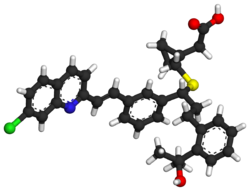 | |
 | |
| Clinical data | |
|---|---|
| Pronunciation | mon te loo' kast |
| Trade names | Singulair, others |
| AHFS/Drugs.com | Monograph |
| MedlinePlus | a600014 |
| License data |
|
| Pregnancy category |
|
| Routes of administration | By mouth |
| Drug class | Leukotriene receptor antagonist |
| ATC code | |
| Legal status | |
| Legal status | |
| Pharmacokinetic data | |
| Bioavailability | 63–73% |
| Protein binding | 99% |
| Metabolism | Liver (CYP2C8-major, CYP3A4 and CYP2C9-minor)[3] |
| Elimination half-life | 2.7–5.5 hours [5] |
| Excretion | Bile duct[5] |
| Identifiers | |
| |
| CAS Number | |
| PubChem CID | |
| IUPHAR/BPS | |
| DrugBank | |
| ChemSpider | |
| UNII | |
| KEGG | |
| ChEBI | |
| ChEMBL | |
| CompTox Dashboard (EPA) | |
| ECHA InfoCard | 100.115.927 |
| Chemical and physical data | |
| Formula | C35H36ClNO3S |
| Molar mass | 586.19 g·mol−1 |
| 3D model (JSmol) | |
| Melting point | 145 to 148 °C (293 to 298 °F) |
| |
| |
| (verify) | |
Montelukast, sold under the brand name Singulair among others, is an antileukotriene medication used in the maintenance treatment of asthma.[6] It is generally less preferred for this use than inhaled corticosteroids.[6] It is not useful for acute asthma attacks.[6] Other uses include allergic rhinitis and hives of long duration.[6] For allergic rhinitis it is a second-line treatment.[7]
Common side effects include abdominal pain, cough, and headache.[6] Severe side effects may include allergic reactions, such as anaphylaxis and eosinophilia,[6] and neuropsychiatric impacts.[8] Use in pregnancy appears to be safe.[6] Montelukast is in the leukotriene receptor antagonist family of medications.[6] It works by blocking the action of leukotriene D4 in the lungs resulting in decreased inflammation and relaxation of smooth muscle.[6]
Montelukast was approved for medical use in the United States in 1998.[6] It is available as a generic medication.[9] In 2022, it was the seventeenth most commonly prescribed medication in the United States, with more than 29 million prescriptions.[10][11]
- ^ "Montelukast (Singulair) Use During Pregnancy". Drugs.com. 13 December 2019. Archived from the original on 7 August 2019. Retrieved 4 March 2020.
- ^ "FDA-sourced list of all drugs with black box warnings (Use Download Full Results and View Query links.)". nctr-crs.fda.gov. FDA. Retrieved 22 October 2023.
- ^ a b Cite error: The named reference
med.org.ukwas invoked but never defined (see the help page). - ^ "Singulair- montelukast sodium granule Singulair- montelukast sodium tablet, chewable Singulair- montelukast sodium tablet, film coated". DailyMed. 29 April 2020. Archived from the original on 15 October 2020. Retrieved 12 October 2020.
- ^ a b "Elsevier – Drug Monograph │Montelukast". Elsevier's Healthcare Hub. 4 March 2020. Archived from the original on 27 January 2023. Retrieved 27 January 2023.
Montelukast and its metabolites are excreted almost exclusively via the bile; less than 0.2% of the drug is excreted in urine. Mean elimination half-life (half-life) of montelukast is 2.7 to 5.5 hours in healthy young adults.
- ^ a b c d e f g h i j Cite error: The named reference
AHFS2018was invoked but never defined (see the help page). - ^ Grainger J, Drake-Lee A (October 2006). "Montelukast in allergic rhinitis: a systematic review and meta-analysis". Clinical Otolaryngology. 31 (5). Wiley: 360–367. doi:10.1111/j.1749-4486.2006.01276.x. PMID 17014443. S2CID 27200676.
- ^ https://www.reuters.com/business/healthcare-pharmaceuticals/us-fda-finds-widely-used-asthma-drug-impacts-brain-2024-11-22/
- ^ British national formulary: BNF 76 (76 ed.). Pharmaceutical Press. 2018. p. 269. ISBN 978-0-85711-338-2.
- ^ "The Top 300 of 2022". ClinCalc. Archived from the original on 30 August 2024. Retrieved 30 August 2024.
- ^ "Montelukast Drug Usage Statistics, United States, 2013 - 2022". ClinCalc. Retrieved 30 August 2024.